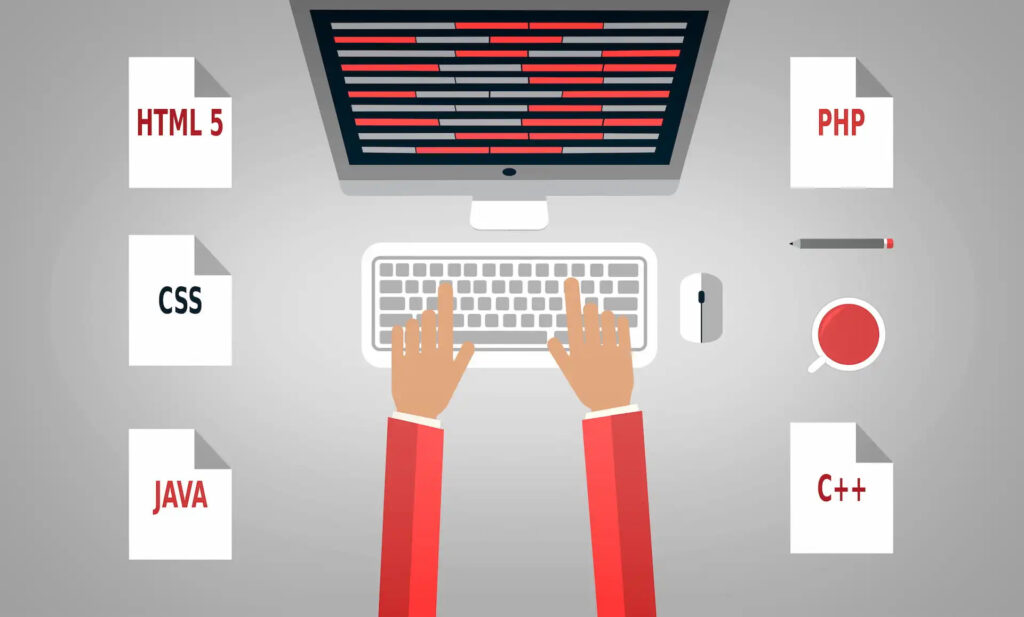The front end is the visible part of a website, with which users interact. Should you learn front-end development as a Data Scientist? Find out the answer.
What is front-end development?
In the field of web development, the notion of “front-end” development is essential. It encompasses the entire part of a website that is visible to the Internet user.
This notion is opposed to the “back end” development, which concerns all the non-visible parts of the website.
Front-end development, also called client-side development, consists in producing HTML, CSS, and Javascript code for a website or a web application. The goal is to allow the user to see and interact with the content.
When you visit a website, all the content you see has been created by a front-end developer. This includes the logo, search bar, buttons, links, animations, or even the general layout and how the user interacts with the page.
The role of the front-end developer is to implement the vision and design conceived by the client through the code. He is in charge of the look and feel of the website and must make sure that the site looks good on mobile as well as on PC.
The main tasks of the front-end developer are creating web pages and updating existing ones, creating HTML emails for communication campaigns, improving the performance of websites by cleaning up the code, and adding accessibility features.

What are the tools of the front-end developer?
A front-end developer must master three programming languages: HTML, CSS, and JavaScript. He must also handle different frameworks, software libraries, and other useful tools.
HTML or HyperText Markup Language is used to display content on the page. This includes buttons, links, titles, paragraphs, or lists.
On the other hand, styling is based on CSS: Cascading Style Sheets. This language is responsible for styling the web page, including colors, layouts, and animations.
Finally, JavaScript allows users to interact with the web page. This language is used for most websites, especially for the operation of menu buttons. It is also used for online games and mobile applications.
The front-end developer also handles the various CSS frameworks and libraries. These tools are designed to speed up the development process.
For example, frameworks such as Bootstrap and Tailwind CSS allow you to add a catalog of classes to a web page for a professional design that is compatible with mobile devices. Other popular frameworks include Bulma, Materialize, and Semantic UI. In addition, preprocessors such as Sass and Less are used to add logic and functionality to CSS code.
Similarly, JavaScript libraries and frameworks are widely used for front-end development. Some of the most popular ones include React, Angular, and Vue. These tools save time and reduce code.
The skills of the front-end developer
A front-end developer must have strong debugging skills, to correct errors in the code during the development of an application. He must also master testing, and know how to write tests to ensure that his code works properly.
Another key skill is version management, which allows you to track and manage changes to the code in a project. One of the most popular software for code tracking is Git. This tool allows you to revert to a previous version of the code in case of an error, rather than having to manually rewrite it.
In addition, Git allows you to collaborate with other developers on a team and make changes to the same code from different geographical locations. Services such as GitHub allow projects to be hosted.
Finally, the front-end developer is a problem-solving expert. This is probably his main skill, as clients expect him to provide solutions.
This professional must be able to break down a problem into smaller pieces and solve the problems in web applications.

Front end vs. back end: what is the difference?
Unlike the front end, the back end is the “server side” of the website. It stores and organizes the data, and also ensures that the client-side part of the website works properly.
It is the part of the website that the user cannot see, and with which he cannot interact. There is no direct contact between the user and the back end.
The back-end developer is in charge of writing APIs, creating libraries, and working with system components without a user interface. He handles PHP, C++, Java, Python, and Node.js languages, and frameworks such as Express, Django, Ruby on Rail, Laravel, and Spring. In short, the front end is the part of the website that users see and the back end is what makes it work.
Front end and Data Science
Front-end development can be very useful for Data Science, especially for DataViz or data visualization. It is essential to know how to create visually appealing reports, graphs, and slides with an interface adapted to mobile devices.
There are Python tools that simplify data visualization for internal applications, such as Streamlit and Plotly Dash. However, these tools are not suitable for presenting data to a broader, less technical audience.
Front-end HTML, CSS, and Javascript are more effective. In addition, front-end development also allows the data scientist to deploy a website that interacts with the Python Flask APIs he writes.
In general, learning front-end development allows the Data Scientist to better understand the work of the developers he collaborates with, and to avoid his work being spoiled by a poor interface.
The front end is very useful to create a responsive design compatible with mobile devices such as smartphones and tablets. The application or DataViz must adapt its display to the screen dimensions.
Moreover, it allows the making of models accessible to other teams via a REST API. The same microservice concept can be applied to websites, to allow the web client to react to user events by sending HTTP requests to the back end.

How to follow a Data Science training?
To become an expert in Data Science, you can choose DataScientest training courses. Our various Data Analyst, Data Scientist, Data Engineer. You will learn Python programming, DataViz, Machine Learning, database manipulation, data analysis, and Business Intelligence.
Through the Data Engineer training, you will learn front-end and back-end development techniques like CI / CD with Git and GitHub or automation and deployment with Docker, Kubernetes, and APIs.
Our programs adopt a blended learning approach combining flexible platform-based learning and Masterclasses led by a Data Scientist. Our pedagogical method is practice-oriented, with online exercises for all modules and a core project.










